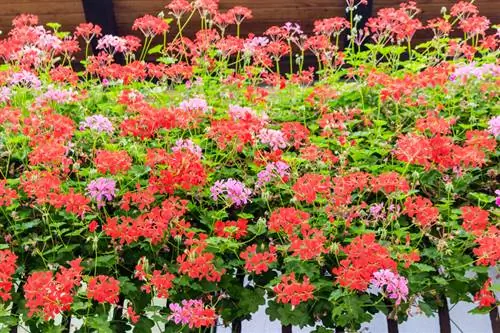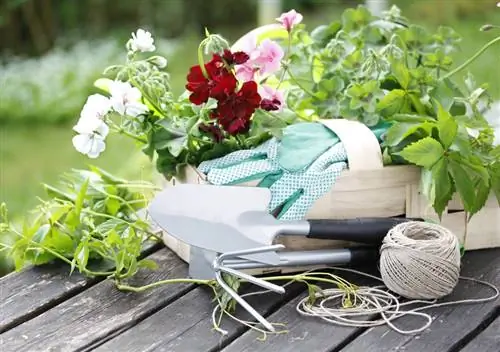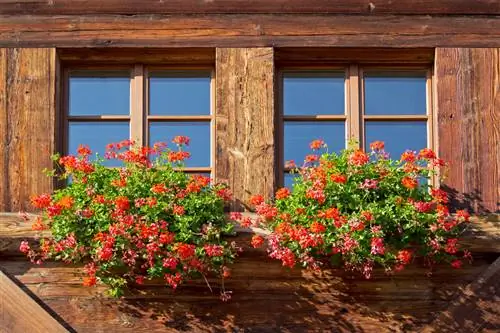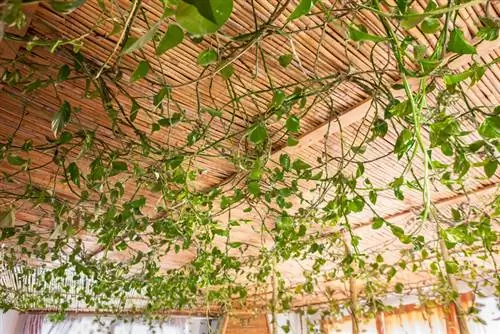- Author admin [email protected].
- Public 2023-12-25 17:45.
- Last modified 2025-01-23 11:20.
They complete the creative balcony box or attract everyone's attention with their flowing blossoms. The opulent blooms of hanging geraniums are less mysterious than it might seem given the abundance of balcony boxes in the Alpine region. In fact, it comes down to a package of harmoniously coordinated criteria when it comes to planting and caring for Pelargonium Peltatum. The following answers to frequently asked questions shed light on the matter.
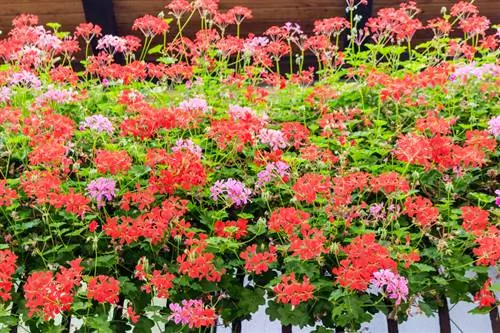
How do you properly care for hanging geraniums?
Hanging geraniums need a sunny location, sufficient water without waterlogging, weekly fertilizer and regular removal of wilted flowers. In winter, cut back the tendrils and overwinter them cool and bright.
Planting hanging geraniums correctly
Choose window boxes that have multiple water drains. The dimensions should not be smaller than 15 cm deep and 20 cm wide. Place a shard of pottery over each opening in the floor or cover the floor completely with a thin layer of small pebbles as a water-bearing base. Add a first layer of geranium soil on top. Pot up the young hanging geraniums and plant them in the loose substrate at a distance of 15-20 cm. Please remove the supporting plastic grid with great sensitivity, because at this stage the tendrils are as fragile as porcelain. Please maintain the previous planting depth if possible and water with water at room temperature.
Care tips
Hanging geraniums are less maintenance-intensive than they seem. With this care program you can set the course for a long and lush flowering period:
- Watere moderately until June and only then increase the amount of water without causing waterlogging
- Fertilize liquid weekly from May to October/November
- After 3 weeks in culture, shorten all shoots slightly until just above a vital bud
- Clean out wilted flowers every 1-2 days
If winter is just around the corner, cut off all tendrils by two thirds of their length and remove the leaves. Now put the flower boxes away in the bright winter quarters with temperatures between 5 and 8 degrees Celsius. Water occasionally without applying fertilizer. In March, cut the shoots back down to 2 strong buds and pot the overwintered plants in fresh soil.read more
Which location is suitable?
The sunny south-facing balcony is the optimal location for hanging geraniums. Place the flower box so that it is protected from strong winds and pelting rain. While the long tendrils can easily cope with a mild summer wind, a rain shower causes significant damage to the flowers.
What soil does the plant need?
Use a high-quality compost-based potting soil as the substrate. It is best to choose a product that is low in peat and has less tendency to compact. A few handfuls of perlite respiration flakes or lava granules increase permeability and optimize oxygen supply to the roots. You will receive the perfect substrate ready-made as special geranium soil, which is of course reflected in the costs.
When is flowering time?
In a sunny, well-protected location, hanging geraniums give you a long flowering period from May until the first frost. One of the mainstays of this long period of time is consistently cleaning out withered flowers before the individual leaves fall off and the foliage sticks together. If this is too time-consuming for you, opt for self-cleaning varieties, such as Pelargonium-Peltatum Ville des Paris.
Cut hanging geraniums correctly
After 3 weeks of growth on the balcony, you are of course happy about every centimeter. However, take heart now and cut the young tendrils back very slightly to just above a he althy, strong bud. With this simple trick you can get your hanging geraniums to branch out lushly and have even more flowers. In the fall, before putting away the plants, radically shorten them by two thirds.
Watering hanging geraniums
Adjust the amount of watering water proportionally to the progress of growth. Until the flowering period begins, only give water when the top 2-3 cm of soil has dried out. Only from June onwards do you gradually increase the quantity, but at no time should waterlogging occur. Thanks to this care, the roots grow better and your hanging geraniums bloom even more luxuriantly.
Fertilize hanging geraniums properly
Hanging geraniums are definitely not food lovers. Therefore, fertilize the heavily depleting summer flowers weekly with a liquid preparation that has plenty of phosphorus in the NPK composition. With a special geranium fertilizer you are playing it safe when it comes to the nutrient composition, which is of course reflected in the price.
Diseases
A mealy-white coating on the hanging geraniums, which have previously bloomed magnificently, indicates the most common disease of these summer flowers. The fungal infection powdery mildew requires your immediate intervention so that the pelargonium does not die. Reaching for a fungicide is still unnecessary, as a tried-and-tested home remedy outweighs the chemical club. Mix 125 ml fresh milk (not long-life milk) with 1 l lime-free water. Spray this solution on the tops and bottoms of the leaves every 2-3 days until symptoms no longer occur.
Wintering
Since all geranium species immigrated to us from warm tropical countries, hanging geraniums cannot tolerate frost either. To ensure that your balcony flowers repeat the blossom festival next year, put the plants away in good time before the first frost. Beforehand, cut the tendrils down to 15 cm and remove all leaves. In a bright spot at 5-8 degrees Celsius, water occasionally to prevent the root ball from drying out. The pelargoniums do not hold fertilizer at this time. In early spring, cut the shoots again so that at least 2 buds remain on them. Now pot the overwintered Pelargonium Peltatum in fresh substrate and gradually accustom them to sunlight and higher temperatures.read more
Propagate hanging geraniums
Take non-flowering head cuttings 10-15 cm long from your most beautiful hanging geraniums in August. These are stripped of their leaves in the lower part, placed in a lean substrate and kept slightly moist in a semi-shady place. By winter, the cuttings have developed their own root system and join the adult pelargoniums in the bright, cool winter quarters.
Is hanging geranium poisonous?
Hanging geraniums pose no he alth risk to humans. Small rodents, on the other hand, can suffer serious damage or even death after eating the plant parts. Therefore, do not use the flowers and leaves as green food for rabbits, hamsters or guinea pigs. Dogs and cats should also not be able to reach the vines.
Beautiful varieties
- Ville de Paris: One of the most popular varieties for lavishly flowering balcony boxes in red and pink
- Tyrolean Fire: Magnificent Tyrolean hanging geranium with bright red flowers on up to 150 cm long tendrils
- Royal Night: Noble Pelargonium-Peltatum with dark purple-red flowers from May to October
- Toscana Nixe: Impresses with two-tone flowers in pink with a red edge and lush branching
- Ville de Dresden: White-flowering trailing geranium with a pink center decorated with up to 100 cm long tendrils

